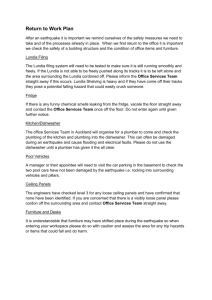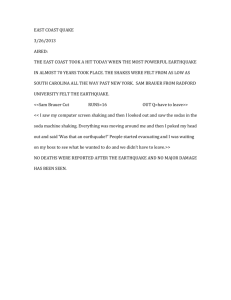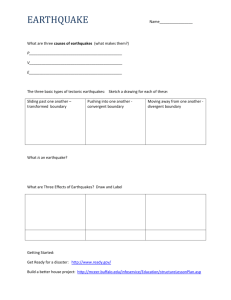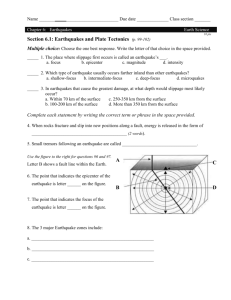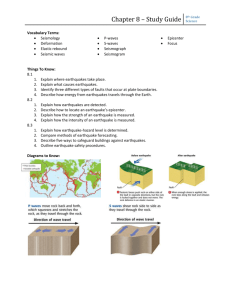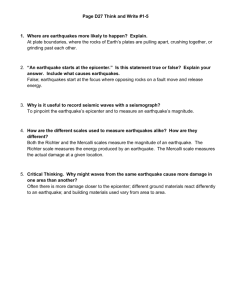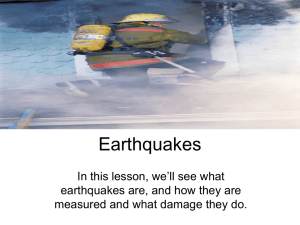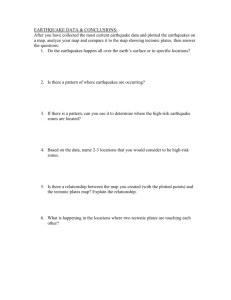Lesson Two: Protect Yourself
advertisement
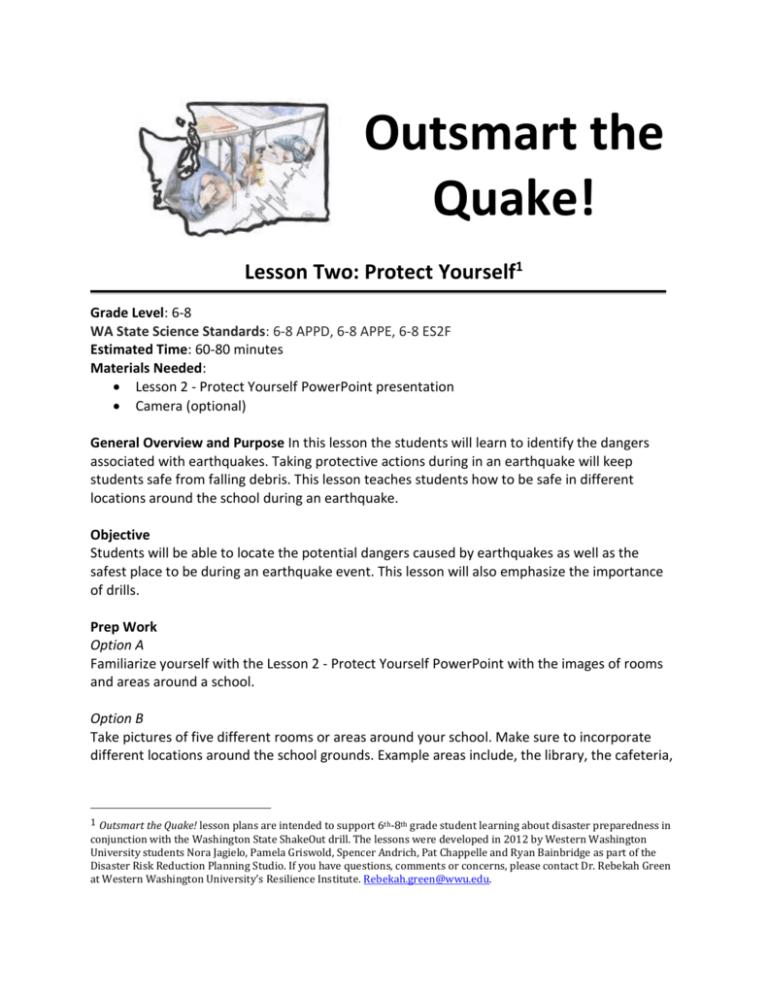
Outsmart the Quake! Lesson Two: Protect Yourself1 Grade Level: 6-8 WA State Science Standards: 6-8 APPD, 6-8 APPE, 6-8 ES2F Estimated Time: 60-80 minutes Materials Needed: Lesson 2 - Protect Yourself PowerPoint presentation Camera (optional) General Overview and Purpose In this lesson the students will learn to identify the dangers associated with earthquakes. Taking protective actions during in an earthquake will keep students safe from falling debris. This lesson teaches students how to be safe in different locations around the school during an earthquake. Objective Students will be able to locate the potential dangers caused by earthquakes as well as the safest place to be during an earthquake event. This lesson will also emphasize the importance of drills. Prep Work Option A Familiarize yourself with the Lesson 2 - Protect Yourself PowerPoint with the images of rooms and areas around a school. Option B Take pictures of five different rooms or areas around your school. Make sure to incorporate different locations around the school grounds. Example areas include, the library, the cafeteria, 1 Outsmart the Quake! lesson plans are intended to support 6th-8th grade student learning about disaster preparedness in conjunction with the Washington State ShakeOut drill. The lessons were developed in 2012 by Western Washington University students Nora Jagielo, Pamela Griswold, Spencer Andrich, Pat Chappelle and Ryan Bainbridge as part of the Disaster Risk Reduction Planning Studio. If you have questions, comments or concerns, please contact Dr. Rebekah Green at Western Washington University’s Resilience Institute. Rebekah.green@wwu.edu. the gymnasium, and outside. Place these images in the Lesson 2 – Protect Yourself PowerPoint as additional or substitute locations. Step Time 1 5-7 minutes 2 7-10 minutes Open up the Lesson 2 - Protect Yourself PowerPoint and use slides one through four to explain the three types of earthquakes experienced in the Pacific Northwest. 5 minutes Transition into a brainstorm session. Open to slide six and ask the students to brainstorm the possible earthquake dangers they see in the picture of the classroom. Refer to Notes for teacher in the PowerPoint slide for the dangers. Next, ask the students to brainstorm the possible dangers that could cause harm in their own classroom. Refer to Appendix B for examples of earthquake dangers. 3 4 5 6 10 minutes 5 minutes 20-25 minutes Description Briefly recap the main points from the previous lesson, by asking the students to explain the difference between a hazard and a disaster. Review the drop cover and hold-on technique by opening slide number seven of the presentation. Dropping to hands and knees at the first signs of an earthquake will prevent students from being thrown to the ground or falling – and any injuries this might cause – during the most intense shaking. Covering their head and neck with their arms will better protect their most vulnerable body parts – eyes, neck, and brain. Taking cover under a desk or near low sturdy furniture will shield students from falling heavy objects such as light fixtures or loose furniture. Holding on to a desk leg or other sturdy furniture under or near which students take cover will ensure they stay with the sturdy furniture even if it slides around during shaking Explain the proper safety strategies for both inside the school and outside (See Appendix B). Begin the “Stay Safe At School” exercise, starting on slide nine of the Lesson 2 - Protect Yourself PowerPoint. The Teacher Notes at the bottom of slide nine has a script to explain the activity to the students. This activity will help the students to identify the possible earthquake dangers in different areas of a school as well as the appropriate actions to take during an earthquake. See Appendix B for activity details. 7 8 5 minutes 5 minutes Debrief the activity: Ask the students to identify the reoccurring dangers and “safe places” throughout the five locations. Conclude the activity: Transition into the next lesson plan by asking the students to think about strategies to transform the classroom into a safer environment. APPENDIX B Step 1 Brief Recap of Previous Lesson A hazard is a human made or natural danger that can threaten a group of people, their belongings, and their environment, if they do not take precautions.2 Examples of hazards in WA: earthquakes, landslides, flooding, oil spill. A disaster is a hazard that causes such great losses and damage that the affected communities do not have the resources to recover without outside assistance.3 In 2005, the United States experienced a disaster when Hurricane Katrina displaced hundreds of thousands of people and the city of New Orleans was completely underwater. Step 2 Earthquake types Deep fault earthquakes occur 21-43 miles below the earth’s surface. They cause shaking over a wide area. The Nisqually Earthquake in 2001 was the last significant deep earthquake in Washington. The earthquake was felt from Salem, Oregon to Vancouver, British Columbia. In the greater Seattle area, sections of roads were damaged; fissures opened up in the ground, and older masonry buildings were damaged. Inside buildings 2 UNISDR & UNICEF, (2004). Let’s learn to prevent disasters! Fun ways for kids to join in risk reduction. Retrieved from website: a.http://www.unisdr.org/2004/campaign/booklet-eng/Booklet-english.pdf (p.4) 3 Vanaspongse, C., Ratanachena, S., Rattanapan, J., Chuthong, S., & Intraraksa, R. (2007). Training manual child-led disaster risk reduction in schools and communities. Save the Children, Retrieved from http://seap.savethechildren.se/Global/scs/SEAP/publication/publication pdf/Disaster/DRR training manual _eng.pdf (p.9) unsecured furniture was overturned and books and other items fell off of shelves. The earthquake lasted for about 40 seconds but very little damage occurred to well-made structures.4 5 6 A shallow fault earthquake can occur anywhere between 0-18 miles below the earth’s surface and these earthquakes are felt intensely (lots of shaking) at the surface. The Seattle fault is an example of a shallow fault that runs through the middle of the city. The Northridge earthquake in California, a shallow fault earthquake, caused the closure of several major highways and caused severe damage to bridges, electrical facilities and pipelines. Inside buildings, unsecured furniture was overturned and there was broken glass from light fixtures.7 8 The Cascadia Subduction Zone is a convergent plate boundary off the Washington coast. The subduction zone extends from Northern California to British Columbia. In 2011, Japan experienced a subduction zone earthquake similar to what could occur on the Cascadia Subduction Zone. Damage to buildings designed for earthquakes was minor but damage to cell phone towers, bridges and water pipes was severe; infrastructure damage included thousands of damaged sections of roads and damage to over 70 bridges. 9 10 Step 3 Preliminary Brainstorming Have the students begin brainstorming the possible dangers associated with earthquakes in their classroom. Record their ideas on the white board. Then ask the students to identify where they should go or how they should behave in the classroom if an earthquake were to occur. Dangers in the classroom: Glass from light fixtures and windows, toppling shelves and cabinets 11 Safe locations/what to do: The ground shaking from earthquakes can cause heavy furniture to fall over, as well as light fixtures to detach from the ceiling and fall. In order 4 Washington State Department of Natural Resources. (2012). Nisqually earthquake of february 28, 2001. Retrieved from http://www.dnr.wa.gov/ResearchScience/Topics/GeologicHazardsMapping/Pages/nisqually_eq.aspx 5 Office of Emergency Management. (2011). Earthquakes. Retrieved from http://www.seattle.gov/emergency/hazards/earthquake.htm 6 Lasmanis, R. (2001). Surviving the nisqually earthquake. Washington Geology, 28(3), 3-5. Retrieved from http://www.dnr.wa.gov/ResearchScience/Topics/GeologicHazardsMapping/Pages/nisqually_eq.aspx (p.3-4) 7 Office of Emergency Management. (2011). Earthquakes. Retrieved from http://www.seattle.gov/emergency/hazards/earthquake.htm 8 Scientists of the U.S. Geological Survey. (1994). Earthquake of 17 January 1994. Science, 226(5184), 389-397. Retrieved from http://www.jstor.org/stable/pdfplus/2885318.pdf (p.395) 9 Walsh, T. J., Gerstel, W. J., Pringle, P. T., & Palmer, S. P. (2012). Earthquakes in washington. Retrieved from http://www.dnr.wa.gov/researchscience/topics/geologichazardsmapping/pages/earthquakes.aspx 10 Kazama, (2011). Damage from the Great East Japan Earthquake and Tsunami - a quick report. Mitigation and Adaptation Strategies for Global Change, 806. 11 FEMA. (2012).Earthquakes. Retrieved from http://www.ready.gov/earthquakes to remain safe during an earthquake, kneel under a desk, table, or other sturdy piece of furniture. The desk will protect the students by shielding them from falling heavy objects such as light fixtures or loose furniture. Kneeling and holding on will keep the students under the desk and prevent the students from falling over in an earthquake. Stay away from windows, hanging light fixtures or any other piece of furniture that might fall over. Windows can easily break, and the broken glass may cause serious harm or injury. Covering your eyes can prevent glass and other debris from causing harm. Stay under the desk until the shaking has stopped. Smaller tremors may come before and after a larger earthquake, so stay under the desk or furniture for at least a few minutes after shaking has stopped.12 13 Step 4 Review of drop cover and hold on: More likely than not, the students have been exposed to the proper technique for drop cover and hold-on, but it would be beneficial to do a brief review. Use the Lesson 2 - Protect Yourself PowerPoint slide seven and eight and have them practice the technique. Step 5 Safety Strategies: 14 15 16 In an earthquake, overhead items may fall and break causing serious harm to an unprotected student. Using self-protection techniques such as Drop Cover and Hold on will help keep students safe by shielding them from dangers such as shattering glass and falling objects. Dropping to hands and knees at the first signs of an earthquake will prevent students from being thrown to the ground or falling – and any injuries this might cause – during the most intense ground shaking. Covering their head and neck with the arms will better protect their most vulnerable body parts – eyes, neck and brain. Taking cover under a desk or near low, sturdy furniture will shield students from falling heavy objects such as light fixtures or loose furniture. Holding on to a desk leg or other sturdy furniture under or near which students take cover will ensure they stay with the sturdy furniture even if it slides during shaking. If the students are inside: 12 FEMA. Federal Emergency Management Agency, (2006). Earthquake Preparedness: What Every Child Care Provider Needs to Know. Pg5 Retrieved from website: http://www.fema.gov/library/file;jsessionid=FD4806BF35750D96DBE9491FD808474A.Worker2Library?type=publishedFile&file=fema240.pdf&fileid=e51ae4c0-1e55-11db-b486-000bdba87d5b 13 14 FEMA. (2012).Earthquakes. Retrieved from http://www.ready.gov/earthquakes FEMA. (2012).Earthquakes, Retrieved from http://www.ready.gov/earthquakes (“during” tab) 15 FEMA. Federal Emergency Management Agency, (2006). Earthquake Preparedness: What Every Child Care Provider Needs to Know. Retrieved from website: http://www.fema.gov/library/file;jsessionid=FD4806BF35750D96DBE9491FD808474A.Worker2Library?type=publishedFile&file=fema240.pdf&fileid=e51ae4c0-1e55-11db-b486-000bdba87d5b 16 American Red Cross. (2012). Preparedness Fast Facts: Earthquakes. Retrieved from http://www.redcross.org/portal/site/en/menuitem.53fabf6cc033f17a2b1ecfbf43181aa0/?vgnextoid=6f461c99b5ccb110VgnVCM10000089f087 0aRCRD&currPage=13cbb969ae282210VgnVCM10000089f0870aRCRD Kneel down under a desk, table, bench or other sturdy piece of furniture. If you are in a room without sturdy furniture, kneel next to an interior wall away from windows, hanging light fixtures, hanging furniture, or any other piece of furniture that might fall over. Hold on to the table leg, desk or whatever piece of furniture you are under. This will keep the table from sliding away from you. Cover your eyes with your free hand and sway with the piece of furniture if it starts to move. Stay under your piece of furniture until shaking has stopped. Sometimes smaller tremors come before and after a larger earthquake, so stay under your piece of furniture for at least a few minutes after shaking has stopped. If you are in a hallway, drop to the ground against a wall and away from windows. Cover your neck with your arm. 17 After the earthquake you will eventually go outside. Make sure to look around your surroundings to identify any dangers such as broken glass or downed power lines that might pose a threat to your safety. 18 If the students are outside: Move into an open area away from buildings, trees, fences, utility wires, playground equipment, or anything else that might fall over. Kneel on the group and cover your head and face. Stay in the open area until shaking has stopped. Sometimes smaller tremors come before and after a larger earthquake, so don’t move for at least a few minutes after shaking has stopped. Step 6 “Safe at School Activity” (suggested time 20-25 min): To begin this activity, open the Lesson 2 – Protect Yourself PowerPoint presentation to slide 9. Included in the PowerPoint are five different locations around a school. The first location (slide nine) is of a classroom. The teacher should instruct the students to raise their hand and identify any possible dangers in the classroom (The students have already brainstormed the dangers from their own classroom so this should be very similar). The instructor will record the answers on the whiteboard. Next, the instructor will call on students to identify all the “safe places” such as desks or up against a wall away from windows. Once the students have a list of both “dangers” and “safe places” compiled on the whiteboard, the instructor will move to the next slide. The following slide has correctly identified “safe places” circled in green, and “dangers” identified by a thin dashed red circle. After each location, the instructor should examine the list 17 Washington Military Dept. Emergency Management Division. (2011). Kids earthquake. Retrieved from http://www.emd.wa.gov/kidz/kidz_secondary.html?content=earthquake1 18 Washington Military Dept. Emergency Management Division. (2011). Kids earthquake. Retrieved from http://www.emd.wa.gov/kidz/kidz_secondary.html?content=earthquake1 the students compiled and compare them to the dangers and safe places identified in the slide by the red and green circles. The students should start to see some common trends for both safe places and dangers. Note: The instructor has the option of using the pictures provided or inserting their own similar pictures of their own school. Locations (1-6): 19 20 21 22 Location 1: Classroom Dangers in the classroom: Potential dangers circled in red include: Glass from light fixtures and windows. These may cause serious injury to eyes and exposed skin. Falling ventilation systems, also circled in red, may cause bodily harm if they were to fall on an individual. Toppling shelves, cabinets and loose bookshelves may cause broken bones, and/or serious head injuries. Safe locations/what to do: In order to remain safe during an earthquake, use the proper Drop Cover and Hold-on technique we previously discussed to kneel down under a desk, table (circled in green), or other sturdy piece of furniture. In this picture the tables circled in green are the safest places to reside in an earthquake event because they will shield the student/adult from falling dangers mentioned above. The ground shaking from earthquakes may also cause heavy furniture to fall over, as well as light fixtures. Sometimes smaller tremors come before and after a larger earthquake, so stay under your piece of furniture for at least a minute after shaking has stopped. Location 2: Gym 19 FEMA. (2012).Earthquakes. Retrieved from http://www.ready.gov/earthquakes *this source provides general description of dangers 20 Walsh, T. Department of Natural Resources, (2012). Earthquakes in Washington http://www.dnr.wa.gov/researchscience/topics/geologichazardsmapping/pages/earthquakes.aspx 21 FEMA. Federal Emergency Management Agency, (2006). Earthquake Preparedness: What Every Child Care Provider Needs to Know. (P 5, 6, 7) Retrieved from website: http://www.fema.gov/library/file;jsessionid=FD4806BF35750D96DBE9491FD808474A.Worker2Library?type=publishedFile&file=fema240.pdf&fileid=e51ae4c0-1e55-11db-b486-000bdba87d5b 22 American Red Cross. (2012). Preparedness Fast Facts: Earthquakes. Retrieved from http://www.redcross.org/portal/site/en/menuitem.53fabf6cc033f17a2b1ecfbf43181aa0/?vgnextoid=6f461c99b5ccb110VgnVCM10000089f087 0aRCRD&currPage=13cbb969ae282210VgnVCM10000089f0870aRCRD Dangers: Potential dangers circled in red include: Glass from windows and light fixtures may cause serious injury to eyes and exposed skin. The debris from athletic equipment, as well as the over-hanging ventilation systems could potentially be deadly or cause serious broken bones and bodily harm if they were to fall on someone. The divider, circled in red, is a potential danger because of its size and weight; it could seriously injure or kill somebody if it were to fall directly on someone. Safe Locations/what to do: There will likely be little furniture to get under, so kneel down next to an interior wall away from windows, hanging light fixtures, and sports equipment. To stay safe, cover your head and face to protect yourself from falling glass shards and remain in this position until shaking has completely stopped. Location 3: Library Dangers: Potential dangers circled in red include: Glass from windows, light fixtures, falling bookshelves. Broken glass can cause severe cuts to exposed skin as well as get into open eyes. Other dangers include bookcases, books, plants on desks, and chairs on desks. Depending on the weight of falling debris, these dangers may cause broken bones, bruises and sever head trauma. Safe Locations/what to do: Kneel down under a desk, table, bench or other sturdy piece of furniture. This will protect you from falling debris. If you are unable to find any sturdy furniture, kneel next to an interior wall away from windows, bookshelves, hanging light fixtures, hanging furniture, or any other piece of furniture that might fall over. Hold on to the table leg, desk or whatever piece of furniture you are under. Cover your eyes with your free hand and move with the piece of furniture if it starts to move. Stay under your piece of furniture until shaking has stopped. Sometimes smaller tremors come before and after a larger earthquake, so stay under your piece of furniture for at least a minute after shaking has stopped. Location 4: In a hallway Dangers: Potential dangers circled in red include: Glass from skylights, windows and overhanging light fixtures. Glass can cut exposed skin and get into eyes. The stairway, also circled in red, can be dangerous as students may slip and fall in the shaking. Safe Locations/what to do: Drop to the ground against an interior wall away from windows, light fixtures and skylights. Make sure you are looking down and protecting your face from falling glass by shielding your eyes. It is also important to cover your neck with your arm to protect yourself from heavy falling objects. Circled in green are the safe location in a high school that satisfy the previous criteria. Location 5: Cafeteria Dangers: Potential dangers circled in red include: Fallen glass from windows and overhanging light-fixtures. Other dangers include picture frames on walls, upright tables, chairs stacked on tables, all of which could cause serious head trauma if they were to fall directly on a student or adult. Moreover, the glass from broken windows and lights can cut exposed skin and get into eyes. Safe Locations/what to do: Kneel down under a cafeteria table (circled in green) to be safe from falling debris (There should be plenty of tables in a cafeteria). If you are unable to find a table, kneel next to an interior wall away from windows, hanging light fixtures, hanging furniture, or any other piece of furniture that might fall over. Hold on to the table leg. With your free hand shield your eyes from falling glass. It is important to stay under the desk for protection, so move with the piece of furniture if it starts to slide. Stay under the piece of furniture until the shaking has stopped. Sometimes smaller tremors come before and after a larger earthquake, so stay under the table or piece of furniture for at least a few minutes after shaking has come concluded. Location 6: Outside near a building Dangers: Potential dangers circled in red include: Glass from windows, outdoor light fixtures, power lines, cars (moving and stationary) as well as falling debris from buildings. Safe Locations/what to do: If you can quickly and safely do so, move into an open area away from buildings, and be careful of glass from outdoor light fixtures and windows. Kneel on the ground and cover your head and face to shield yourself from falling glass shards. Stay in the open area until shaking has stopped. Sometimes smaller tremors come before and after a larger earthquake, so don’t move for at least a minute after shaking has stopped. Step 7 Debriefing: The students will begin a 5-10 minute debriefing of the activity. The instructor should ask the students to list both the reoccurring dangers associated with earthquakes throughout the 5 scenarios as well as all the reoccurring safe places. The instructor will have the class identify and group together the common dangers and safe places evident in all scenarios. It is important for students to know they can be safe in all locations around their school. Wrap-up questions: Which dangers concern you the most? Why? What can we do to protect yourself from these dangers?
